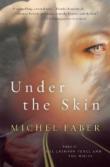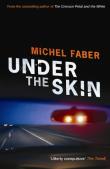AustLit
Latest Issues
AbstractHistoryArchive Description
'Isserley is a female driver who picks up hitchhikers with big muscles. She, herself, is tiny, peering child-like over the steering wheel. Scarred and awkward, yet strangely erotic and threatening, she hears passengers reveal who might miss them if they should disappear.' (Publication summary)
Adaptations
-
form
y
 Under the Skin
( dir. Jonathan Glazer
)
United Kingdom (UK)
:
Film4
British Film Institute
Silver Reel
,
2013
7792586
2013
single work
film/TV
science fiction
Under the Skin
( dir. Jonathan Glazer
)
United Kingdom (UK)
:
Film4
British Film Institute
Silver Reel
,
2013
7792586
2013
single work
film/TV
science fiction
'A mysterious woman seduces lonely men in the evening hours in Scotland. Events lead her to begin a process of self-discovery.' (Production summary)
Publication Details of Only Known VersionEarliest 2 Known Versions of
Other Formats
- Sound recording.
- Large print.
Works about this Work
-
Non/human Appetites and the Perils of Consumption in Under the Skin
2019
single work
criticism
— Appears in: Critique (Washington) , vol. 60 no. 2 2019; (p. 157-168)'This article examines the complex and shifting appetites for meat and sex in Michel Faber’s 2000 novel Under the Skin and the 2013 Jonathan Glazer film adaptation of the book. Although almost unrecognizable at the level of plot, this article argues that considering these texts together highlights their deep and unsettling rendering of misogyny in relation to the pleasures and perils of consumption. In engaging with the confronting and, at times, politically ambiguous treatment of consumption in these texts, this article offers a reading of the intersectional relationship between the oppression of women in a patriarchal society and the exploitation of nonhuman animals as a resource for human endeavors.' (Publication abstract)
-
Johansson's Real Performance : Documentary Style in Under the Skin
2018
single work
criticism
— Appears in: Science Fiction Film and Television , Spring vol. 11 no. 1 2018; (p. 29-35)'Sf might seem an odd genre in which to place documentary values, even though it has historically utilised principles of realism to enhance its verisimilitude.1 It characteristically prizes the fantastical, and Under the Skin is exemplary of the genre insofar as the unnamed alien protagonist scours the streets of Glasgow for male civilians to capture and process.The setting is portrayed with strategic familiarity - plainly dressed shoppers, indiscernible chatter, harsh fluorescent lighting and the recognisable signage of chain stores distinguish the space.Eight bespoke cameras were fitted into the front of the actress/ heroine's van - behind mirrors, headrests and vents - to document the pickups.Under the Skins marketing campaign participates in this destabilisation of Johansson's image by drawing the audience's attention to the presence of the real within the cruising scenes.' (Publication abstract)
-
Fault Lines in Under the Skin (Glazer, 2013) : An Ethics and Aesthetics of the ‘monstrous’
2017
single work
criticism
— Appears in: Horror Studies , April vol. 8 no. 1 2017; (p. 45-59)'An adaptation of Michel Faber’s 2000 novel about alien invasion that updates the scifi horror tradition of the 1970s in an art-cinema mode, Under the Skin (Glazer, 2013) offers a stellar example of the ‘monstrous’ as both figure and form. Generally speaking, the interstitiality of the ‘monstrous’ demands strategies grounded in the disconnection between categories (image and sound, diegetic and nondiegetic), some of which have become horror movie clichés. Under the Skin is no exception. Its aesthetics of instability, correlated to a ‘monstrous’ figure that casts a defamiliarizing gaze on our world before attempting to ‘become human’, produces a complex subtext on contemporary alienation and identity politics, that puts the viewer in a position where he or she must both take moral responsibility for the categories he or she constructs (such as the ’monstrous’), and experience the mysterious physicality at the core of life itself.' (Publication summary)
-
Eating One’s Friends : Fiction as Argument in Bioethics
2016
single work
criticism
— Appears in: Literature and Medicine , Spring vol. 34 no. 1 2016; (p. 79-105)'In this essay, I argue that literature has been profoundly misunderstood by scholars of bioethics.
'Bioethicists in analyzing moral problems have often drawn upon literary texts as sources for “rich cases,” for they have long recognized that the traditional genre of the ethics case was limited in its portrayal of the complexity of the moral landscape of actual medical practice. This traditional utilization of literature in bioethics is critically examined by James Terry and Peter Williams in an essay published in Literature and Medicine: “Short stories and poems that are evocative, complex, and imaginatively challenging have been used to supplement or supplant the traditional case study as instruments for raising ethical issues. At best, these literary works more vividly present moral questions and even raise some kinds of issues that case studies leave out.” The real purpose of Terry and Williams’s essay is to sound an alarm on this casual, unreflective use of literature: while literary works may at first appear to furnish desirable descriptions of moral problems, they caution, these texts and bioethics cases have distinct, and at times divergent, goals.' (Publication abstract)
-
Unearthly Stranger
Jonathan Romney
(interviewer),
2014
single work
interview
— Appears in: Sight and Sound , April vol. 24 no. 4 2014; (p. 22-24, 26-27) 'An interview with filmmaker Jonathan Glazer is presented. Glazer discusses adapting the book "Under the Skin" by Michael Faber for the screen. He also discusses his shooting techniques and using hidden cameras, actress Scarlett Johansson's performance and sexual image, and the film's score, written by Mica Levi.' (Publication abstract)
-
Untitled
2006
single work
review
— Appears in: 1001 Books You Must Read Before You Die 2006; (p. 896)
— Review of Under the Skin 2000 single work novel -
Of Humans, Pigs, Fish, and Apes: The Literary Motif of Human-Animal Metamorphosis and Its Multiple Functions in Contemporary Fiction
2006
single work
criticism
— Appears in: Esprit Createur , Summer vol. 46 no. 2 2006; (p. 68-88) -
“It’s a Question of Words, Therefore” : Becoming-Animal in Michel Faber’s Under the Skin
2011
single work
criticism
— Appears in: Science Fiction Studies , March vol. 38 no. 1 2011; (p. 134-154) 'This essay reads Michel Faber's debut novel Under the Skin (2000) in the context of contemporary philosophical and literary-critical debates about the ethical relation between human and nonhuman animals. It argues that Faber's text engages with, but deconstructs, the traditional division of "no language, no subjectivity" by a heretical act of renaming human beings as "vodsels," and by an extensive process of figurative transformation. The paper then proceeds to a sustained analysis of the main character in the novel, Isserley, in the light of Gilles Deleuze and Felix Guattari's theories of becoming-animal, the anomalous, and becoming-molecular. The paper concludes that the novel engages in the limitrophy—Derrida's neologism—required to negotiate the abyssal limit between the human and nonhuman animal.' (Editor's abstract)
-
Eating One’s Friends : Fiction as Argument in Bioethics
2016
single work
criticism
— Appears in: Literature and Medicine , Spring vol. 34 no. 1 2016; (p. 79-105)'In this essay, I argue that literature has been profoundly misunderstood by scholars of bioethics.
'Bioethicists in analyzing moral problems have often drawn upon literary texts as sources for “rich cases,” for they have long recognized that the traditional genre of the ethics case was limited in its portrayal of the complexity of the moral landscape of actual medical practice. This traditional utilization of literature in bioethics is critically examined by James Terry and Peter Williams in an essay published in Literature and Medicine: “Short stories and poems that are evocative, complex, and imaginatively challenging have been used to supplement or supplant the traditional case study as instruments for raising ethical issues. At best, these literary works more vividly present moral questions and even raise some kinds of issues that case studies leave out.” The real purpose of Terry and Williams’s essay is to sound an alarm on this casual, unreflective use of literature: while literary works may at first appear to furnish desirable descriptions of moral problems, they caution, these texts and bioethics cases have distinct, and at times divergent, goals.' (Publication abstract)
-
Unearthly Stranger
Jonathan Romney
(interviewer),
2014
single work
interview
— Appears in: Sight and Sound , April vol. 24 no. 4 2014; (p. 22-24, 26-27) 'An interview with filmmaker Jonathan Glazer is presented. Glazer discusses adapting the book "Under the Skin" by Michael Faber for the screen. He also discusses his shooting techniques and using hidden cameras, actress Scarlett Johansson's performance and sexual image, and the film's score, written by Mica Levi.' (Publication abstract) -
Fault Lines in Under the Skin (Glazer, 2013) : An Ethics and Aesthetics of the ‘monstrous’
2017
single work
criticism
— Appears in: Horror Studies , April vol. 8 no. 1 2017; (p. 45-59)'An adaptation of Michel Faber’s 2000 novel about alien invasion that updates the scifi horror tradition of the 1970s in an art-cinema mode, Under the Skin (Glazer, 2013) offers a stellar example of the ‘monstrous’ as both figure and form. Generally speaking, the interstitiality of the ‘monstrous’ demands strategies grounded in the disconnection between categories (image and sound, diegetic and nondiegetic), some of which have become horror movie clichés. Under the Skin is no exception. Its aesthetics of instability, correlated to a ‘monstrous’ figure that casts a defamiliarizing gaze on our world before attempting to ‘become human’, produces a complex subtext on contemporary alienation and identity politics, that puts the viewer in a position where he or she must both take moral responsibility for the categories he or she constructs (such as the ’monstrous’), and experience the mysterious physicality at the core of life itself.' (Publication summary)
-
cScotland,ccUnited Kingdom (UK),cWestern Europe, Europe,






